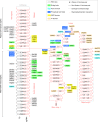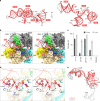Structural basis for the promiscuous PAM recognition by Corynebacterium diphtheriae Cas9
- PMID: 31036811
- PMCID: PMC6488586
- DOI: 10.1038/s41467-019-09741-6
Structural basis for the promiscuous PAM recognition by Corynebacterium diphtheriae Cas9
Abstract
The RNA-guided DNA endonuclease Cas9 cleaves double-stranded DNA targets bearing a protospacer adjacent motif (PAM) and complementarity to an RNA guide. Unlike other Cas9 orthologs, Corynebacterium diphtheriae Cas9 (CdCas9) recognizes the promiscuous NNRHHHY PAM. However, the CdCas9-mediated PAM recognition mechanism remains unknown. Here, we report the crystal structure of CdCas9 in complex with the guide RNA and its target DNA at 2.9 Å resolution. The structure reveals that CdCas9 recognizes the NNRHHHY PAM via a combination of van der Waals interactions and base-specific hydrogen bonds. Moreover, we find that CdCas9 exhibits robust DNA cleavage activity with the optimal 22-nucleotide length guide RNAs. Our findings highlight the mechanistic diversity of the PAM recognition by Cas9 orthologs, and provide a basis for the further engineering of the CRISPR-Cas9 genome-editor nucleases.
Conflict of interest statement
J.S.G., O.O.A. and F.Z. are co-founders of Sherlock Biosciences. O.O.A. and J.S.G. are advisors for Beam Therapeutics. J.S.G. is a campus advisor of Benchling, Inc. F.Z. is a co-founder and advisor of Editas Medicine, Arbor Biotechnologies, Beam Therapeutics, and Pairwise Plants. H.N. is an advisor of EdiGENE. O.N. is a co-founder and advisor of EdiGENE. The remaining authors declare no competing interests.
Figures







References
Publication types
MeSH terms
Substances
Grants and funding
LinkOut - more resources
Full Text Sources
Miscellaneous

